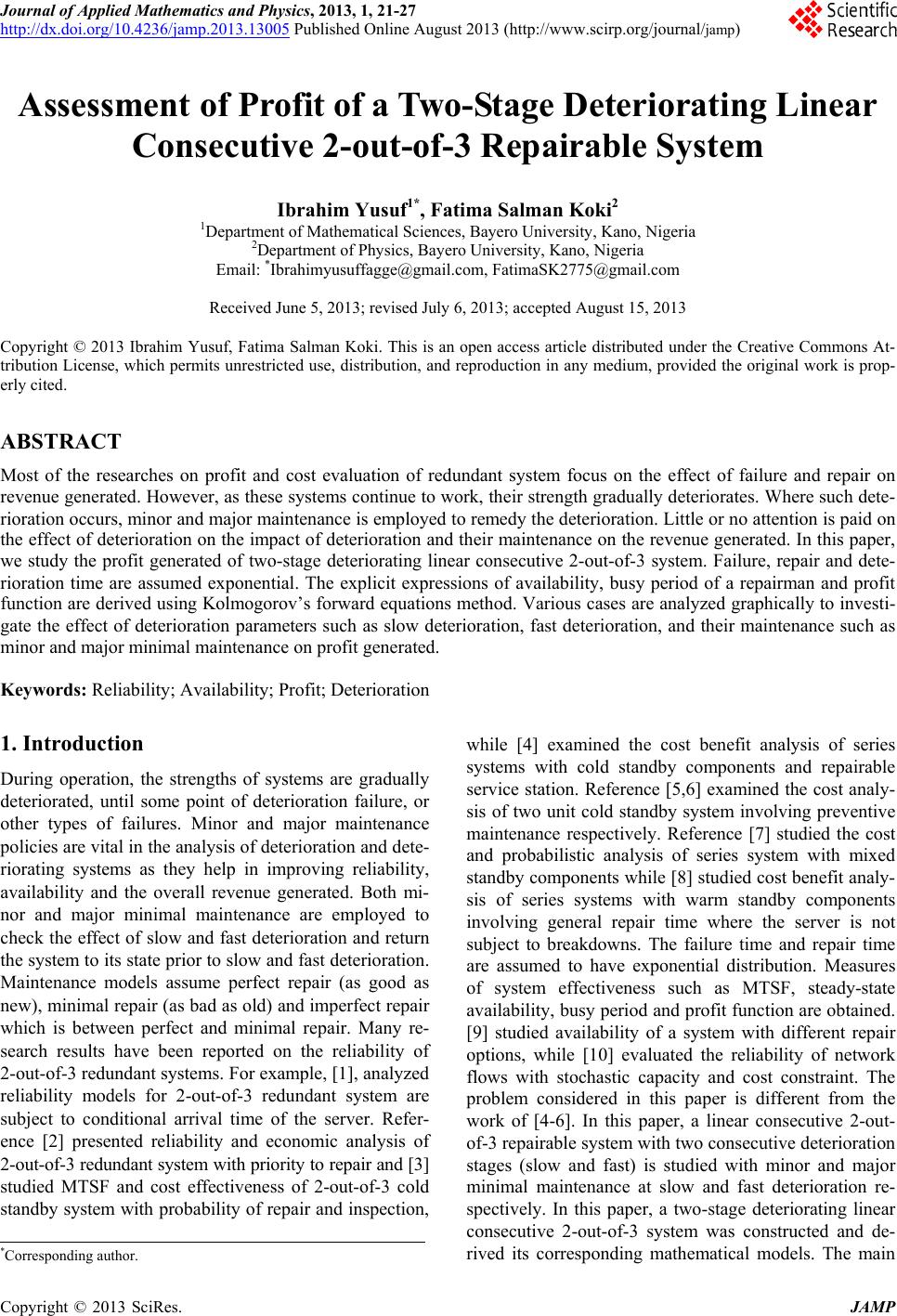
Journal of Applied Mathematics and Physics, 2013, 1, 21-27
http://dx.doi.org/10.4236/jamp.2013.13005 Published Online August 2013 (http://www.scirp.org/journal/jamp)
Assessment of Profit of a Two-Stage Deteriorating Linear
Consecutive 2-out-of-3 Repairable System
Ibrahim Yusuf1*, Fatima Salman Koki2
1Department of Mathematical Sciences, Bayero University, Kano, Nigeria
2Department of Physics, Bayero University, Kano, Nigeria
Email: *Ibrahimyusuffagge@gmail.com, FatimaSK2775@gmail.com
Received June 5, 2013; revised July 6, 2013; accepted August 15, 2013
Copyright © 2013 Ibrahim Yusuf, Fatima Salman Koki. This is an open access article distributed under the Creative Commons At-
tribution License, which permits unrestricted use, distribution, and reproduction in any medium, provided the original work is prop-
erly cited.
ABSTRACT
Most of the researches on profit and cost evaluation of redundant system focus on the effect of failure and repair on
revenue generated. However, as these systems continue to work, their strength gradually deteriorates. Where such dete-
rioration occurs, minor an d major maintenance is employed to remedy the deterioration . Little o r no attentio n is paid on
the effect of deterioration on the impact of deterioration and their maintenance on the revenue generated. In this paper,
we study the profit generated of two-stage deteriorating linear consecutive 2-out-of-3 system. Failure, repair and dete-
rioration time are assumed exponential. The explicit expressions of availability, busy period of a repairman and profit
function are derived using Kolmogorov’s forward equations method. Various cases are analyzed graphically to investi-
gate the effect of deterioration parameters such as slow deterioration, fast deterioration, and their maintenance such as
minor and major minimal maintenance on profit generated.
Keywords: Reliability; Availability; Profit; Deterioration
1. Introduction
During operation, the strengths of systems are gradually
deteriorated, until some point of deterioration failure, or
other types of failures. Minor and major maintenance
policies are vital in the analysis of deterioration and d ete-
riorating systems as they help in improving reliability,
availability and the overall revenue generated. Both mi-
nor and major minimal maintenance are employed to
check the effect of slow and fast deterioration and return
the system to its state prior to slow and fast deterioration.
Maintenance models assume perfect repair (as good as
new), minimal repair (as bad as old) and imperfect repair
which is between perfect and minimal repair. Many re-
search results have been reported on the reliability of
2-out-of-3 redu nd ant systems. For example, [1], analyzed
reliability models for 2-out-of-3 redundant system are
subject to conditional arrival time of the server. Refer-
ence [2] presented reliability and economic analysis of
2-out-of-3 redundant system with priority to repair and [3]
studied MTSF and cost effectiveness of 2-out-of-3 cold
standby system with probability of rep air and inspection,
while [4] examined the cost benefit analysis of series
systems with cold standby components and repairable
service station. Reference [5,6] examined the cost analy-
sis of two unit cold standby system involving preventive
maintenance respectively. Reference [7] studied the cost
and probabilistic analysis of series system with mixed
standby componen ts while [8] studied cost benefit analy-
sis of series systems with warm standby components
involving general repair time where the server is not
subject to breakdowns. The failure time and repair time
are assumed to have exponential distribution. Measures
of system effectiveness such as MTSF, steady-state
availability, busy p eriod and profit fun ction are obtained.
[9] studied availability of a system with different repair
options, while [10] evaluated the reliability of network
flows with stochastic capacity and cost constraint. The
problem considered in this paper is different from the
work of [4-6]. In this paper, a linear consecutive 2-out-
of-3 repairable system with two consecutive deterioration
stages (slow and fast) is studied with minor and major
minimal maintenance at slow and fast deterioration re-
spectively. In this paper, a two-stage deteriorating linear
consecutive 2-out-of-3 system was constructed and de-
rived its corresponding mathematical models. The main
*Corresponding author.
C
opyright © 2013 SciRes. JAMP